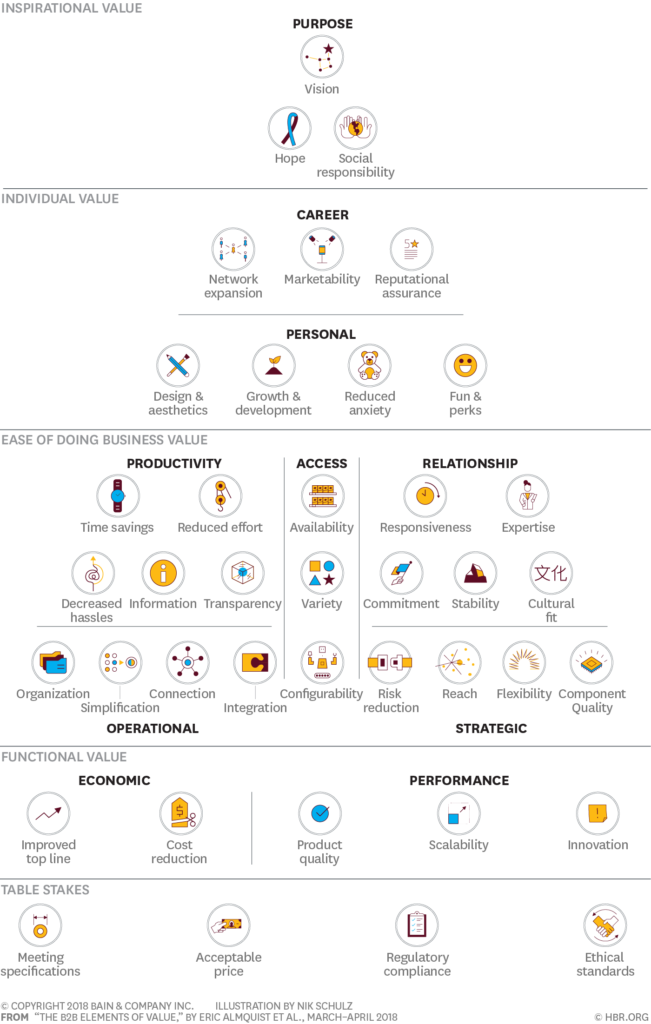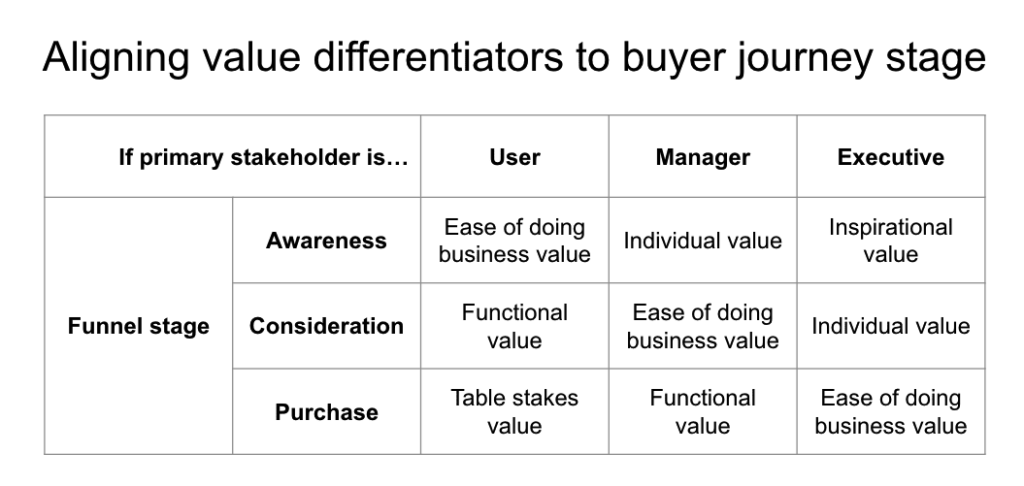Hi, I’m James. Thanks for checking out Building Momentum: a newsletter to help startup founders and marketers accelerate SaaS growth through product marketing.
Just like your value proposition, you’re going to find most success when you tailor the differentiators you use to two things: the primary stakeholder, and the buyer journey stage.
I learnt the value proposition lesson the hard way, when we launched a new product but had messaged towards executive-level concerns on the homepage – without realising that the folks coming to our website were mostly managers. They didn’t care about the aspirational messaging, and instead needed more tangible content.
It’s exactly the same with the differentiators that you’ll want to call out.
Showcase the wrong differentiators to the wrong person at the wrong time, and you’ll be missing out on impact, momentum, and revenue.
In this post:
But first, what’s a differentiator?
Your competitive differentiators are just that… what makes you different from your competitors. It’s not your pricing, your product features, or your branding.
I like using the Bain Elements of B2B Value Pyramid to illustrate value and differentiators.
The pyramid starts at the base with “table stakes,” which are the basic requirements and functional elements of value that customers expect from any product. As we move up the pyramid, the elements of value become less tangible and more about the implications of using the product – first within the organization, then what matters to the individual buyer.
The next level is “functional value,” which includes things like product performance and reliability. Above that is “ease of doing business value,” which includes things like responsive customer service and streamlined ordering processes.
Moving further up the pyramid, we come to “individual value,” which includes things like reputation assurance and reduced anxiety. At the top of the pyramid is “inspirational value,” which includes hope, vision, and social responsibility. Here, differentiators aim to align the vendor with the buyer’s cultural and ethical worldview.
The pyramid is a useful tool for understanding your competitive differentiators because it shows that not all differentiators are created equal. The most tangible and functional elements of value may be important, but they may not be what ultimately sets you apart from the competition. By understanding the different levels of value in the pyramid, you can more effectively communicate the unique benefits of your product to each stakeholder at each stage of the buyer journey.
You can read more about the pyramid here.

Take a minute to read through and understand the different groupings: tablestakes, functional value, ease of doing business value, individual value, and inspirational value.
You can’t really create differentiators, only discover them. What is it about your product that draws buyers to you, and not to others?
Aligning value differentiators
My experience suggests that there are two main ways to segment and combine differentiators: by the stakeholder, and the funnel stage. It looks something a bit like this:

Let’s take a look at the two axes.
Differentiators by stakeholder
Just like my failed product launch example above, the type of stakeholder you’re communicating to changes the starting point.
Generally:
- Users are concerned with the day-to-day. They want information features, they want to build a functional understanding of your product.
- Managers want functional information, but they’re looking for benefits too. They want to understand what the product is going to help them achieve over a medium timeframe.
- Execs are more interested in the aspirational direction that your product can support them to achieve in the long-term.
This will definitely vary, but generally I’ve seen these patterns repeated many times over the last ~12 years.
Differentiators by buyer journey
Your buyer journey is not the sales funnel. Hopefully you’ve got a good understanding of the expedition they go on to solve problems and buy solutions.
- At the awareness stage, your differentiators should focus on grabbing attention and building interest. You want to differentiate your product from the competition and highlight its unique value with what matters most to the stakeholder. You’re answering the ‘why’ at this stage.
- At the consideration stage, your differentiators should focus on providing more detailed information about how it addresses the buyer’s specific needs. You want to demonstrate how your product solves their problems better than the competition, and provide evidence of its effectiveness. You’re answering ‘how’ at this stage.
- At the purchase stage, you should focus on reinforcing the buyer’s decision to choose your product by highlighting differentiators that answer and reinforce the specific ‘what’ that each stakeholder is looking for.
Putting these both together
So if we combine both the primary stakeholder and the funnel stage, we get something like this:

At the awareness stage, you want to stand out and resonate with the differentiators that your stakeholder is going to engage with the most.
- For users, that’s things that will make their life easier – time savings, how much more organized they can be, the configurability.
- For managers, it’s about individual value – what do they stand to gain from working with you? Things like reputational assurance or the reduced anxiety they’ll feel using your product.
- For execs, you’ll engage best on inspirational value. Aspirational differentiators that get them pumped up about what they could achieve in the long-term.
During the consideration stage, you’re showcasing ‘how’ your product helps the stakeholder to achieve all the stuff you just said in the awareness stage.
- For users, show functional differentiators, the performance and economic impact of your product.
- For managers, make it real and show how your product differentiators make it easier to do business.
- For execs, it’s individual value differentiators that appeal most at this stage. You’ve said what the long-term vision is, but now the differentiators that matter will give them confidence.
Finally, at the purchase stage your differentiators are not high-level aspirational things – but rather, the extremely tangible components – because you’ve already sold the story and highlighted your unique values that separates you from the pack on the intangible.
- For users, tablestake differentiators will get them motivated. Price, specifications, and compliance.
- For managers, it’s that functional value that will help them – the performance and economic impact
- For execs, differentiators that matter here are about the ease of doing business with your product – configurability, responsiveness, fit, quality, and so on.
An example
Here’s how the matrix might look for a project management tool. See how the potential differentiators at each stage map back to the elements discussed in the B2B Elements of Value pyramid?

So what does this all mean?
Understanding your competitive differentiators is critical to your success – even more so, knowing where and when to use them.
Using the Bain Elements of B2B Value Pyramid and the framework above, you can align them to the needs and priorities of each stakeholder at each stage of the buyer journey. You can stand out from the competition, and provide the right mix of value to the right stakeholders at the right time.
Remember though: differentiators cannot be created; they can only be discovered. By focusing on what makes your product or service unique in the mind of your customer, you can provide value that truly resonates with your customers, build momentum, and find success.
Thanks for reading! Let me know what you thought – find me on Twitter and LinkedIn.
P.S. If you’ve found value in Building Momentum, could you buy me a coffee? Here’s my tip jar – any support is gratefully appreciated!
P.P.S: If you enjoyed this post, will you share Building Momentum with your network?